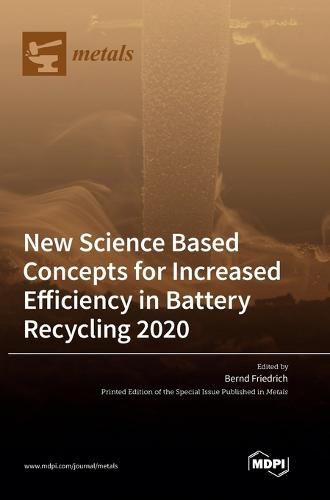Readings Newsletter
Become a Readings Member to make your shopping experience even easier.
Sign in or sign up for free!
You’re not far away from qualifying for FREE standard shipping within Australia
You’ve qualified for FREE standard shipping within Australia
The cart is loading…






This title is printed to order. This book may have been self-published. If so, we cannot guarantee the quality of the content. In the main most books will have gone through the editing process however some may not. We therefore suggest that you be aware of this before ordering this book. If in doubt check either the author or publisher’s details as we are unable to accept any returns unless they are faulty. Please contact us if you have any questions.
Based on 19 high-quality articles, this Special Issue presents methods for further improving the currently achievable recycling rate, product quality in terms of focused elements, and approaches for the enhanced mobilization of lithium, graphite, and electrolyte components. In particular, the target of early-stage Li removal is a central point of various research approaches in the world, which has been reported, for example, under the names early-stage lithium recovery (ESLR process) with or without gaseous CO2 and supercritical CO2 leaching (COOL process). Furthermore, many more approaches are present in this Special Issue, ranging from robotic disassembly and the dismantling of Li-ion batteries, or the optimization of various pyro- and hydrometallurgical as well as combined battery recycling processes for the treatment of conventional Li-ion batteries, all the way to an evaluation of the recycling on an industrial level. In addition to the consideration of Li distribution in compounds of a Li2O-MgO-Al2O3-SiO2-CaO system, Li recovery from battery slags is also discussed. The development of suitable recycling strategies of six new battery systems, such as all-solid-state batteries, but also lithium-sulfur batteries, is also taken into account here. Some of the articles also discuss the fact that battery recycling processes do not have to produce end products such as high-purity battery materials, but that the aim should be to find an "entry point" into existing, proven large-scale industrial processes. Participants in this Special Issue originate from 18 research institutions from eight countries.
$9.00 standard shipping within Australia
FREE standard shipping within Australia for orders over $100.00
Express & International shipping calculated at checkout
This title is printed to order. This book may have been self-published. If so, we cannot guarantee the quality of the content. In the main most books will have gone through the editing process however some may not. We therefore suggest that you be aware of this before ordering this book. If in doubt check either the author or publisher’s details as we are unable to accept any returns unless they are faulty. Please contact us if you have any questions.
Based on 19 high-quality articles, this Special Issue presents methods for further improving the currently achievable recycling rate, product quality in terms of focused elements, and approaches for the enhanced mobilization of lithium, graphite, and electrolyte components. In particular, the target of early-stage Li removal is a central point of various research approaches in the world, which has been reported, for example, under the names early-stage lithium recovery (ESLR process) with or without gaseous CO2 and supercritical CO2 leaching (COOL process). Furthermore, many more approaches are present in this Special Issue, ranging from robotic disassembly and the dismantling of Li-ion batteries, or the optimization of various pyro- and hydrometallurgical as well as combined battery recycling processes for the treatment of conventional Li-ion batteries, all the way to an evaluation of the recycling on an industrial level. In addition to the consideration of Li distribution in compounds of a Li2O-MgO-Al2O3-SiO2-CaO system, Li recovery from battery slags is also discussed. The development of suitable recycling strategies of six new battery systems, such as all-solid-state batteries, but also lithium-sulfur batteries, is also taken into account here. Some of the articles also discuss the fact that battery recycling processes do not have to produce end products such as high-purity battery materials, but that the aim should be to find an "entry point" into existing, proven large-scale industrial processes. Participants in this Special Issue originate from 18 research institutions from eight countries.